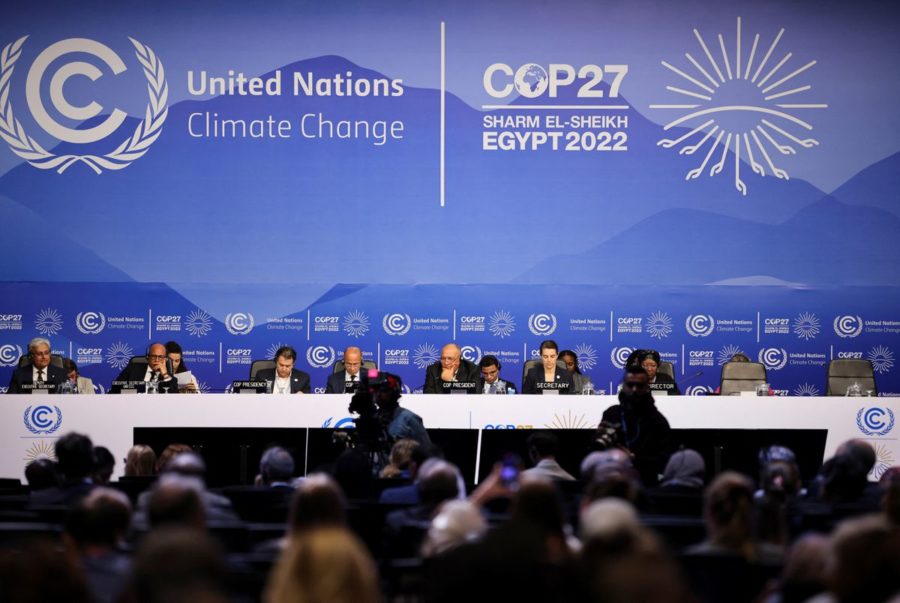What was accomplished at COP27 (and what wasn’t)
By Jessie Cohen
As we close 2022, I wanted to take a moment to reflect back on the largest climate change international conference of the year, COP27, and talk about what was accomplished, and what wasn’t.
November’s United Nations Climate Change Conference (or COP27) in Sharm El Sheikh, Egypt drew over 33,000 delegates, and some very mixed reactions. While some major steps were taken in the fight for climate action, many in attendance felt that what was accomplished wasn’t enough, especially in light of the urgency with which we need to act to mitigate the worst effects of climate change. Some attendees were also concerned about the large presence of fossil fuel lobbyists. Despite the disappointment and criticisms of attendees and activists, the conference did culminate in some major wins for climate justice.

Loss and Damages
Perhaps the biggest piece of legislation to come out of COP27 is the approval of the loss and damages fund. The approval of this fund marks a huge milestone toward climate equity. The phrase “loss and damages” can also be thought of as climate reparations, a concept that centers around the fact that countries who have contributed very little to the climate crisis are experiencing some of its worst effects, and that those countries who have contributed greatly to the crisis have an obligation to help them adapt to their changing environment. Historically, major polluters like the United States and members of the EU have opposed paying compensation for loss and damages to impacted countries. However, COP27 marked a shift in the international mindset, and after two days of intense negotiations, the final text for the fund was approved.
The loss and damages fund is both a diplomatic and moral win, but concerns linger regarding the specifics of the fund. In the report, it is not made clear who will actually pay. Countries who have gotten rich from polluting are the obvious answers, but what about middle income countries who have also made money from polluting? Along with that, where is the line between high and middle income countries? In addition to neglecting to specify who will pay, the text also does not specify how much money will be in the fund, or whether the money in the fund will be coming out of the budget for other environmental initiatives, like adaptation.
While the real impact of the fund itself is somewhat dubious, this conference was also the first COP in which countries pledged significant amounts of money toward loss and damages initiatives. Monetary commitments to various developing nations came from countries including Austria, Belgium, and New Zealand, and totaled over US$300 million. Both the fund and these commitments show a shifting international mindset on the idea of loss and damages, and pave the way for future reparations.

(Lack of) Action on carbon emissions
At the conference, it was announced that carbon dioxide emissions have once again hit record highs. If this trend continues at the same rate, it will take just nine years for the planet to hit 1.5 degrees Celsius of warming, a catastrophic milestone in the climate crisis. Avoiding reaching the 1.5 degrees of warming threshold was set and agreed upon as a goal in 2015 in the Paris Agreement, but emissions have continued to rise.
Despite this warning, the conference failed to produce meaningful action on curbing carbon emissions. The conference’s cover document, referred to as the Sharm el-Sheikh implementation plan, drew language from the Paris Agreement as well as last year’s Glasgow Climate Pact when addressing carbon emissions. However, the language in the statement is weak, stating that it “requests” countries to re-evaluate their emissions in order to align with the Paris Agreement. In general, the implementation plan neglects addressing the oil and gas sectors and their impact on the climate.
The president of COP26, Alok Sharma, spoke during the conference’s closing remarks. His remarks on the emissions portion of the implementation plan were harsh:
“We joined with many parties to propose a number of measures that would have contributed to this. Emissions peaking before 2025, as the science tells us is necessary. Not in this text. Clear follow-through on the phase down of coal. Not in this text. A clear commitment to phase out all fossil fuels. Not in this text. ”
While the conference’s final cover text did not address cutting emissions, the conference did yield some major steps in the transition toward a greener energy future and just energy transitions in developing economies. Just before the conference, South Africa pitched an $84 billion decarbonization plan for the country to move away from coal to green energy. Unfortunately, the Just Energy Transition Partnership (JETP), a fund set up by wealthy countries to assist these kinds of transitions, has agreed to fund only 9% of the plan, but the plan includes pathways to obtain the necessary funding, including grants and private investment.
Additionally, at the concurrent G20 summit in Bali, Indonesia, the UK announced a US$20 billion plan to help Indonesia, another heavily coal dependent country, transition to green energy.
Presence of fossil fuel interests
One of the biggest criticisms of COP27 was the high number of fossil fuel lobbyists in attendance. This year, 636 of the conference’s attendees were representatives of the oil and gas industries. This number is up 25% from COP26, and higher than the amount of representatives from any frontline community, meaning the fossil fuel industries likely had more influence over what happened at the conference than communities suffering the worst effects of climate change.
Fossil fuel lobbyists, along with oil producing countries, effectively stonewalled any attempt to cut emissions. Laurence Tubiana, CEO of the European Climate Foundation, called out the delegation, saying, “The influence of the fossil fuel industry was found across the board… The Egyptian Presidency has produced a text that clearly protects oil and gas petro-states and the fossil fuel industries.”
International cooperation
COP27 disappointed on several fronts. But, it also saw several international commitments toward various climate goals:
- A US-led pledge to reduce methane emissions by 30% by 2030 that was introduced at COP26 received around 60 new signatories.
- A pact between Brazil, Indonesia, and the Democratic Republic of the Congo (a group of countries referred to by campaigners as the “OPEC of rainforests”), who are home to more than 50% of the world’s tropical rainforests, stated that the three nations planned to create a “sustainable funding mechanism” to tackle deforestation.
- The Beyond Gas and Oil Alliance, whose members include Denmark, Costa Rica, France, Greenland, Ireland, Sweden, and Wales, committed to a plan to phase out oil and gas production in member countries. The UK, along with 26 other countries, launched the Forests and Climate Leaders’ Partnership which aims to stop and reverse deforestation by 2030.

Takeaways
COP27 made painfully obvious the influence of corporate interests on our ability to take meaningful climate action. The presence of oil and gas lobbyists and rich oil producing countries blocked action on curbing emissions across the conference. The lack of progress on this critical issue by COP27 is incredibly disappointing. But the conference wasn’t a complete loss, as strides were made toward addressing loss and damages, and commitments were made by countries across the globe (including major polluters) to assist in the transition to green energy and create a just energy future.
For real progress to be made, all countries must be held accountable to these commitments and continue to act with the urgency this crisis demands. We must move away from capitalistic, corporate interests in favor of human interest, because the conference made clear that these two interests cannot truly co-exist. When we start prioritizing people we can make real change, and it seems this year’s COP made good progress in that direction.
I look forward to seeing how COP momentum moves into 2023 and beyond.
